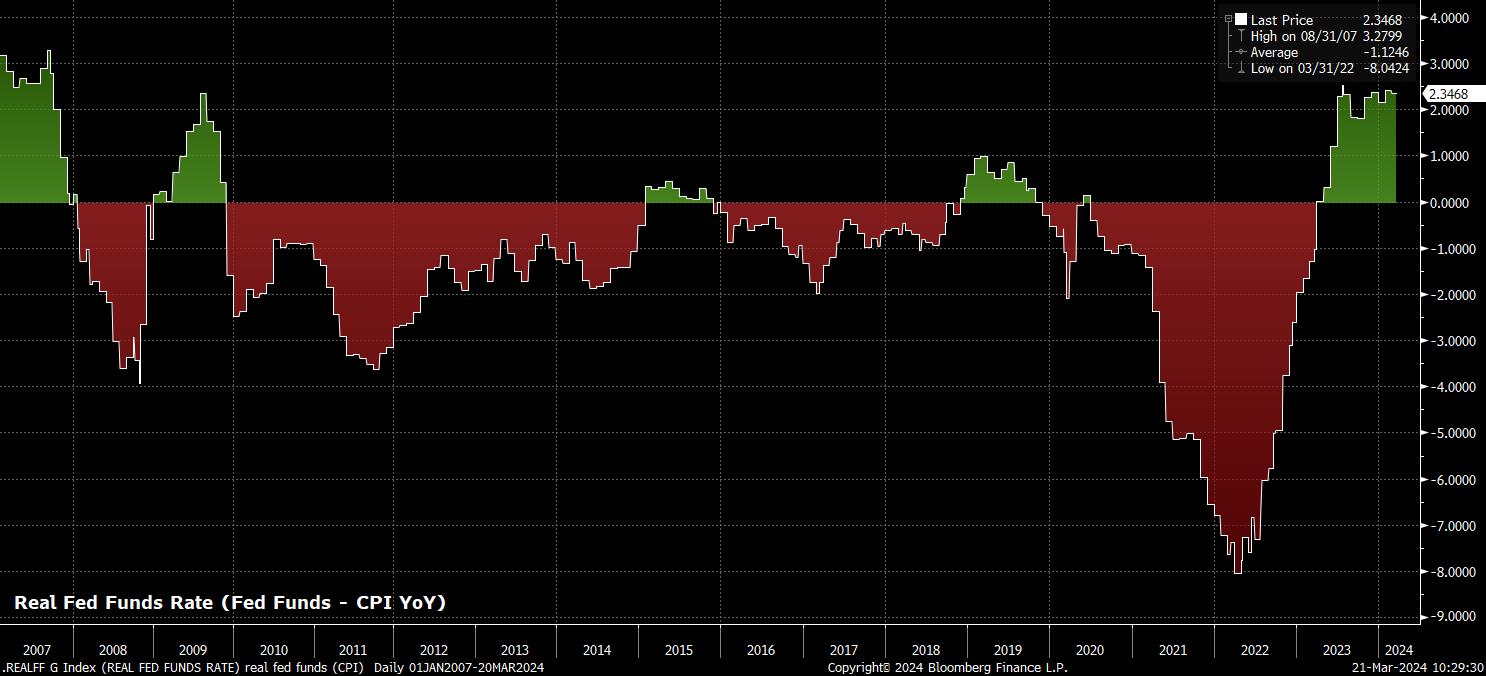- English
- عربي
Yes, on the FOMC, folk will excite themselves about the modest upward revision to the inflation projections, and the subsequent marginally higher dots in 2025, 2026, and the longer-run fed funds rate estimate. Even if, as is well known at this point, the dots, beyond the current year, are notoriously unreliable in projecting the rate path, with even FOMC officials themselves discounting the utility of the dots as a forecasting tool.
But, overall, one must ask the question, has anything significantly shifted in terms of the FOMC outlook?
The answer there is, to be frank, a resounding no.
Will the Fed still cut this year? Yes, of course, with the dot plot median still pointing to 75bp of easing in 2024, and the nominal fed funds rate having to be reduced as inflation continues to recede, in order to avoid a mechanical – and undesirable – tightening in monetary policy late in the cycle, which would risk choking economic growth, and throwing into doubt the ‘soft landing’ that the economy currently looks set for.

Will the Fed still bring QT to an end this year? Yes; discussions over the appropriate balance sheet policy took place at this meeting, and should be elaborated upon in the minutes due in a few weeks. A QT taper at the June meeting, with the process to conclude by the end of the year, still seems reasonable.
Are the FOMC still flexible? Yes, with inflation heading back towards the 2% target, the Fed have earnt the right to bring the ‘put’ back to the table – if the labour market were to drastically weaken, growth roll-over, or a financial accident to occur, the Committee can and will ease policy if necessary, either via rate cuts, or via targeted liquidity injections to sectors that may be most adversely affected.
All this combined leaves markets, basically, where they were before the March statement/SEP/presser dropped. With the ‘Fed put’ back, alive, well, and even more flexible than it was before, market participants should continue to have confidence in increasing their risk exposure, knowing that policymakers once more ‘have their backs’.
Of course, that’s not to say that risks do not remain. Geopolitics is one; sticky inflation another; and, continued hot earnings growth another.
It is also not to say that a drawdown, or pullback, in equities is not impossible. The 50-day moving average in the S&P 500 sits around 5% below the index’s current level, and seems a logical level to hold in the event of any move lower.

It is, however, to say, that the path of least resistance should continue to lead higher for risk assets, with dips remaining relatively shallow. Although risk remains, the easier policy backdrop – not just from the FOMC, but also from G10 peers – should continue, to a significant degree, insulate stocks from the fluid geopolitical backdrop, and keep a lid on equity vol.
FX and rates vol, however, should continue to tick higher, particularly after the SNB became the first G10 central bank to cut this cycle, evidencing how easing cycles across G10 will take place at a differing pace, and to differing magnitudes, providing renewed policy divergence, and thereby trading opportunity, within the FX space.
Related articles
The material provided here has not been prepared in accordance with legal requirements designed to promote the independence of investment research and as such is considered to be a marketing communication. Whilst it is not subject to any prohibition on dealing ahead of the dissemination of investment research we will not seek to take any advantage before providing it to our clients. Pepperstone doesn’t represent that the material provided here is accurate, current or complete, and therefore shouldn’t be relied upon as such. The information, whether from a third party or not, isn’t to be considered as a recommendation; or an offer to buy or sell; or the solicitation of an offer to buy or sell any security, financial product or instrument; or to participate in any particular trading strategy. It does not take into account readers’ financial situation or investment objectives. We advise any readers of this content to seek their own advice. Without the approval of Pepperstone, reproduction or redistribution of this information isn’t permitted.


